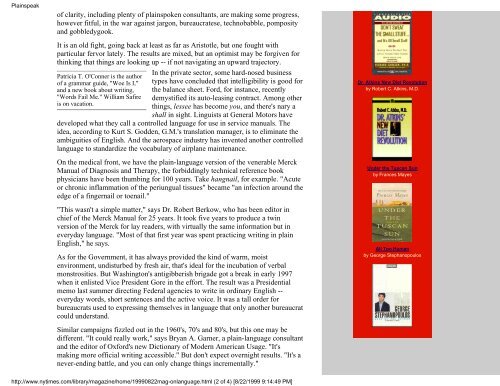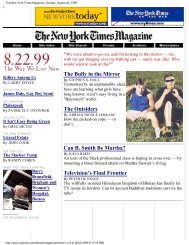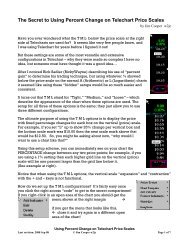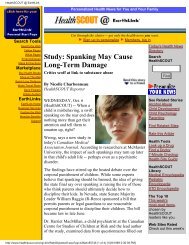The New York Times Magazine, Sunday, August 22, 1999
The New York Times Magazine, Sunday, August 22, 1999
The New York Times Magazine, Sunday, August 22, 1999
You also want an ePaper? Increase the reach of your titles
YUMPU automatically turns print PDFs into web optimized ePapers that Google loves.
Plainspeak<br />
of clarity, including plenty of plainspoken consultants, are making some progress,<br />
however fitful, in the war against jargon, bureaucratese, technobabble, pomposity<br />
and gobbledygook.<br />
It is an old fight, going back at least as far as Aristotle, but one fought with<br />
particular fervor lately. <strong>The</strong> results are mixed, but an optimist may be forgiven for<br />
thinking that things are looking up -- if not navigating an upward trajectory.<br />
Patricia T. O'Conner is the author<br />
of a grammar guide, "Woe Is I,"<br />
and a new book about writing,<br />
"Words Fail Me." William Safire<br />
is on vacation.<br />
In the private sector, some hard-nosed business<br />
types have concluded that intelligibility is good for<br />
the balance sheet. Ford, for instance, recently<br />
demystified its auto-leasing contract. Among other<br />
things, lessee has become you, and there's nary a<br />
shall in sight. Linguists at General Motors have<br />
developed what they call a controlled language for use in service manuals. <strong>The</strong><br />
idea, according to Kurt S. Godden, G.M.'s translation manager, is to eliminate the<br />
ambiguities of English. And the aerospace industry has invented another controlled<br />
language to standardize the vocabulary of airplane maintenance.<br />
On the medical front, we have the plain-language version of the venerable Merck<br />
Manual of Diagnosis and <strong>The</strong>rapy, the forbiddingly technical reference book<br />
physicians have been thumbing for 100 years. Take hangnail, for example. "Acute<br />
or chronic inflammation of the periungual tissues" became "an infection around the<br />
edge of a fingernail or toenail."<br />
"This wasn't a simple matter," says Dr. Robert Berkow, who has been editor in<br />
chief of the Merck Manual for 25 years. It took five years to produce a twin<br />
version of the Merck for lay readers, with virtually the same information but in<br />
everyday language. "Most of that first year was spent practicing writing in plain<br />
English," he says.<br />
As for the Government, it has always provided the kind of warm, moist<br />
environment, undisturbed by fresh air, that's ideal for the incubation of verbal<br />
monstrosities. But Washington's antigibberish brigade got a break in early 1997<br />
when it enlisted Vice President Gore in the effort. <strong>The</strong> result was a Presidential<br />
memo last summer directing Federal agencies to write in ordinary English -everyday<br />
words, short sentences and the active voice. It was a tall order for<br />
bureaucrats used to expressing themselves in language that only another bureaucrat<br />
could understand.<br />
Similar campaigns fizzled out in the 1960's, 70's and 80's, but this one may be<br />
different. "It could really work," says Bryan A. Garner, a plain-language consultant<br />
and the editor of Oxford's new Dictionary of Modern American Usage. "It's<br />
making more official writing accessible." But don't expect overnight results. "It's a<br />
never-ending battle, and you can only change things incrementally."<br />
http://www.nytimes.com/library/magazine/home/<strong>1999</strong>08<strong>22</strong>mag-onlanguage.html (2 of 4) [8/<strong>22</strong>/<strong>1999</strong> 9:14:49 PM]<br />
Dr. Atkins <strong>New</strong> Diet Revolution<br />
by Robert C. Atkins, M.D.<br />
Under the Tuscan Sun<br />
by Frances Mayes<br />
All Too Human<br />
by George Stephanopoulos






